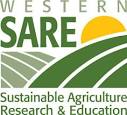Additional Resources
Article in Progressive Dairy: Adding Birdsfoot Trefoil to the Mix
Adding Birdsfoot Trefoil to the Mix, by Kaylee Mecham, Progressive Dairy 15. August 23, 2022. Researchers found that adding birdsfoot trefoil to the mix increases growth and economic returns for producers raising replacement heifers on pasture using rotational grazing. Read more at https://www.agproud.com/articles/55693-adding-birdsfoot-trefoil-to-the-mix
Publications from the Project
- Fonnesbeck, Sawyer. Influence of cattle breed and forage type on organic dairy heifer performance.. M.S. thesis, Utah State University, Logan. 2021.
- Hadfield, Jacob A., Blair L. Waldron, S. Clay Isom, Ryan Fuez, Ryan Larsen, J. Earl Creech, Marcus F. Rose, Jennifer Long, Rhonda L. Miller, Kerry A. Rood, Allen Young, Rusty Stott, Alexis Sweat, and Kara J. Thornton. The effects of organic grass and grass-birdsfoot trefoil pastures on Jersey heifer development: Heifer growth, performance, and economic impact. Journal of Dairy Science. Available at https://www.journalofdairyscience.org/article/S0022-0302(21)00790-6/fulltext
- Miller, R., B. Waldron, S. C. Isom, K. Thornton-Kurth, K. Rood, E. Creech, M. Peel, J. Hadfield, R. Larson, and M. Rose. 2022. Improving Production and Minimizing Nutrient Loss in Grazing Systems through the Use of Grass-Legume Mixtures. eXtension Waste to Worth: Advancing Sustainability in Animal Agriculture. Waste-to-Worth 2022 Proceedings. Available at: https://lpelc.org/improving-production-and-minimizing-nutrient-loss-in-grazing-systems-through-the-use-of-grass-legume-mixtures/
- Miller, R., B. Waldron, C. Isom, K. Thornton-Kurth, K. Rood, E. Creech, M. Peel, M. Rose, and J. Hadfield. 2021. Nutrient Cycling in an Organic Dairy Grazing System. In 2021 American Society of Agronomy Abstracts. Madison, WI: American Society of Agronomy.
- Rose, M.F., B.L. Waldron, S.C. Isom, M.D. Peel, K. Thornton, R. Miller, K.A. Rood, J.A. Hadfield, J. Long, B. Henderson, and J.E. Creech. (2021) The effects of grass and grass-legume pastures on dairy heifer development: Herbage characteristics affecting intake. Journal of Dairy Science. Available at https://www.journalofdairyscience.org/article/S0022-0302(21)00559-2/fulltext
- Rose, Marcus F.; Creech, Earl; Waldron, Blair L.; Isom, S. Clay; Peel, Michael; Thornton-Kurth, Kara; Hadfield, Jacob; and Rood, Kerry A. (2020). "Pasture Management to Improve Dry Matter Intake". 2099.https://digitalcommons.usu.edu/extension_curall/2099
- Sears, A. and Rood, Kerry A. Ruminant Bloat. (2019). Utah State University Fact Sheet. All Current Publications. https://digitalcommons.usu.edu/extension_curall/2017/
- Stewart, EK, JJ. Villalba, and KA Rood. 2018. [Fact Sheet] Environmental and Animal Benefits when Beef Cattle Consume Condensed and Hydrolysable Tannins. Utah State University Fact Sheet AG/Forage/2018-01pr at: https://digitalcommons.usu.edu/cgi/viewcontent.cgi?article=2872&context=...
Research Reports
- USDA NIFA OREI Final Report 2017-51300-26866 Economic and Environmental Sustainability of Forage-Based Heifer Development Strategies in Pasture-Based Organic Dairy Systems. Available here.
- Western SARE Progress Report SW21-927 Dry Matter Intake and Feed Efficiency of Four Dairy Breeds in a Pasture-Based Heifer Development Program. Available here.
- Western SARE Final Report SW17-046 Grass-birdsfoot trefoil mixtures to improve the economic and environmental sustainability of pasture-based organic dairies in the western U.S.: Available at https://projects.sare.org/project-reports/sw17-046/. The report concluded:
- The number of grazing dairies is increasing, but decreased herbage intake by grazing livestock reduces the performance of dairy cattle. Therefore, it is important to identify herbage characteristics inherent to various pasture species that affect intake. We confirmed that grass-birdsfoot trefoil mixtures have greater herbage intake by grazing Jersey heifers than grass monocultures (Table 1 from Rose et al. Journal of Dairy Science paper). Furthermore, 50% of the intake differences were due to characteristics of the herbage; with fiber, energy, and percent birdsfoot trefoil most predictive. These findings indicate that mixtures of high-energy grasses and as little as 14% birdsfoot trefoil increase intake of temperate pastures by grazing Jersey heifers.
- Jersey heifers developed on organic pasture in the Intermountain West region of the US have decreased performance compared to those in conventional confinement. As the number of organic dairies increases, new strategies are needed to improve performance. This research indicates Jersey heifers developed on organic grass pastures interseeded with the legume birdsfoot trefoil have similar performance to heifers raised in a conventional confinement setting (non-organic) and improved performance compared to heifers on organic grass monoculture pastures (Table 2 from Hadfield et al. Journal of Dairy Science manuscript). These findings provide a potential solution for producers to improve performance of heifers in an organic pasture-based setting.
- This study also evaluated economic impacts of grazing organic replacement dairy heifers on four cool-season pasture grasses both as monocultures and as mixtures with the tannin-containing non-bloating legume birdsfoot trefoil (BFT). Results were benchmarked against a conventional system feeding a mixed ration in confinement. All pasture treatments, but perennial ryegrass monoculture, were expected to be economically viable; however, the BFT mixed pastures were determined to be better investments as compared to the monoculture pastures (Table 7 from Hadfield et al. Journal of Dairy Science manuscript). This research demonstrates possible economic benefits of organic heifer programs as compared to conventional, which may alleviate some producer concerns when considering an organic operation.
Funding
Funding for these projects was provided by

Western SARE grants SW17-046 and 2SW21-927

USDA NIFA OREI grant 2017-51300-26866
